Norwegian frigate Helge Ingstad is understood to be listing heavily after collision with a tanker.
Local media are reporting that the vessel was deliberately run aground at port in Norway in order to prevent sinking.
The 127 crew has been evacuated, 8 members of the crew are understood to have suffered injuries.
Eirik Walle, of Norway’s rescue centre, told Norwegian news agency NTB that the collision caused an opening in the frigate’s hull and “it is taking in more water than they can pump out. There is no control over the leak and the stern is heavily in the sea.”
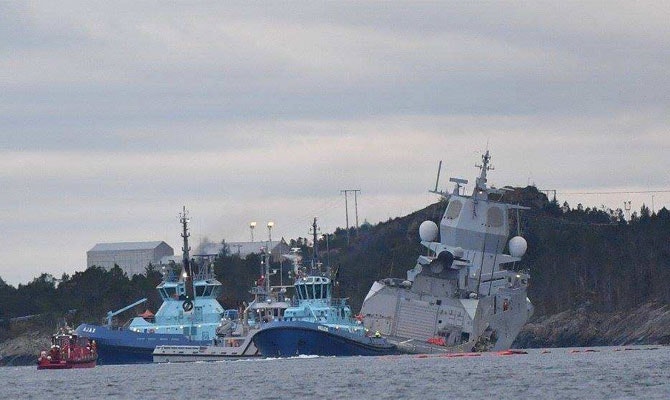 Johan Marius Ly of the Norwegian Coast Guard said the 134-meter (442-foot) -long frigate was listing, adding “we have been told that there is a leak from the frigate. It should be a helicopter fuel, but the extent of leakage is unknown.”
Johan Marius Ly of the Norwegian Coast Guard said the 134-meter (442-foot) -long frigate was listing, adding “we have been told that there is a leak from the frigate. It should be a helicopter fuel, but the extent of leakage is unknown.”
The class are the main surface combatants of the Royal Norwegian Navy. The ships are named after famous Norwegian explorers, with the lead ship of the class bearing the name of Fridtjof Nansen.
Five ships were ordered from Spanish shipbuilder Bazan at a cost of $2.54 billion.



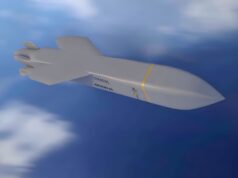
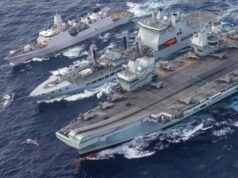
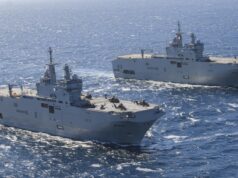

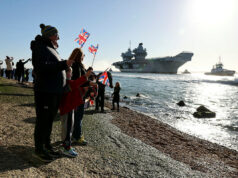


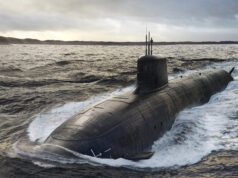
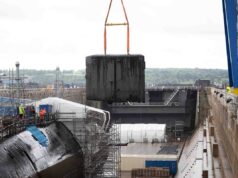
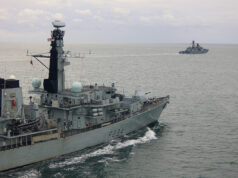

I hope all involved recover well…
A reminder of how fragile frigates really are in comparison to the old battleships. If a collision can do this to a warship, what could a modern antiship missile do with a 1000lb warhead? Game over.
What did it collide with a rock? I’m no expert but it still seems a bit worrying that this could be enough to sink a modern frigate. Are there not enough bulkheads below the waterline that will seal the impacted compartments? These things are supposed to be built with the expectation of a hull breach.
All of the recent (Post Falklands) damage to UK frigates and destroyers has come from groundings and collisions. These have been when the ships have been doing there general business sailing around on the ocean. The exception was Southampton who was at a higher Damage Control state because she was doing Tanker Convoy escorting in the Gulf.
Having a 1k lb warhead come inboard is a lot different.
Chances are you would be at action stations or defense watches.
You would know if it was inbound unlike the rocks Brazen and Nottingham hit.
The ship would be in the highest damage control state with most if not all doors and hatches closed (1Z or 2Y)and damage control teams closed up.
With doors and hatches closed flooding can be contained and managed using eductors, portable pumps, shoring and cement boxes. However this is increasingly difficult to manage on a lean maned ship. You need boots on the deck when the fires are burning and the water is rising. A cctv camera in a machinery space that reduces the need for a watch keeper to conduct rounds is not going to be able to help bang a wooden wedge into a hole that’s pissing in water. Lean manning and automation is not a panacea.
Sadly the fashion of defence on the cheap could cost us very dear in lives. Giving ordinary people decent careers in the military is essential to properly man our ships. Cutting manpower is very short sighted as Gunbuster correctly points out.
I would say a good chance of mission kill, but as long as watertight integrity is maintained and the crew have their DC down then there would be a chance the hull could survive. The USS Stark took two Exocet in the Gulf and survived. What took Sheffield down was water from the fighting not the initial missile strike. A big hull like a Daring would do well if it hit somewhere not too vital (everywhere is vital). There are things too. Provision of pumps is vital as well as fuel to run them. Sprinklers and not depending on a single fire main might be an idea. I think some German ships designed and built after the Falklands had double bulkheads; the explosion hits one, deforms it, but its ‘partner’ remains intact.
Post Falklands, UK new warships had most of the systems divided up around the ship.
Fire pumps, air compressors, fire main, chilled water, data networks etc. They are all separate and isolated from the next system at action stations. If it all goes wrong you can cross connect, bridge or breach the systems to get capability back to the damaged area.
The RN spends a lot of time and effort in training and practicing Battle Damage Repair and Damage Control. You need to know the systems, the fuse boxes, valves, secondary supplies etc so that you can restore some if not all capability back to the operators.
Even old battleships suffered from being rammed or running aground. Being rammed by a tanker that outweighs you 10 to 1 would ruin any ships day
In light of this development, RFA Diligence was retired without replacement discuss…
I don’t think Diligence could do much for her. She lacked the high capacity pumps it would take to get enough water out so damage control could take place.
I’m just guessing from the pictures, but if the crew have closed down all the damaged compartments (which I’m confident they will have), then she has lost too much buoyancy through bilging. I suspect in open water, she’d have capsized or sunk before anything could be achieved.
Cuts. Just like all the rest.
As important as it is for Dili to be replaced, saving this ship would have been beyond her capabilities.
Not replacing RFA Diligence – one of the most stupid defense decisions ever.
Looks like the stern is now completely underwater, with a heavy list developing. Some stellar work by the crew/tug crews, but it looks like they may be fighting a losing battle.
Thoughts to our Norwegian colleagues.
Can HMG assist at all? Norway one of UKs closest allies.
It’s a job for a proffesional salvage company. The only reason the ship is not a new chart correction is because the CO got her aground in time.
I would imagine whatever assets we have in the area will have been offered, but probably nothing the Norwegians haven’t already got close by. Isn’t salvage one of Norway’s areas of expertise?
The last photo I saw showed the ship almost entirely on its side… I am not sure if a low tide can help them get it re-floated but the gash seems to be enormous at almost half the length of the ship!
Not sure refloating is what they have planned if it has a ruddy great hole in the side. I fear it’s not going anywhere until they plug that. If it can be kept in place, would the next step be a very large barge with a crane?
I hear the Russians have a Fully submersible Dry Dock/Barge !
It only goes down though…
The salvors will get her secure in position, pump out any oil and ensure her munitions are removed.
She’s lost a lot of buoyancy so she either needs patching and pumping out or buoyancy devices fitted. I suspect the latter.
If anyone can save her, the Norwegians can. I used to run a marine heavy-lift contract there and they (and the Dutch) are good at it. Depending on where up the coast it happened, they’ll also have ready access to lots of offshore industry assets. Fingers crossed.
Hoping the injured are ok but wondering who screwed up
This link gives a clear picture of how much she is listing with video footage.
http://www.thedrive.com/the-war-zone/24776/badly-damaged-norwegian-frigate-intentionally-ran-aground-after-tanker-collision
Looking on YouTube, there seems to be damage to the Port Side in one Picture and the same on the Starboard side in another. Confused Much Am I.
Having Studied all the Pictures including the YouTube footage, It appears that one Image has been posted back to front or the negative has been reversed. Confused no longer am I.
Hope everyone Is Ok.
There’s film on BBC of what appears to have a tug trying to nudge her off a rock. Looking at the state of her afterwards this may not have been a good idea.
Yeah just seen the same footage, didn’t look like the smartest move.
Yes it would appear they made things a lot worse, I assume she slipped of the rock or something she was leaning on! very sad state of affairs, if they recover her, its likely to be a very expensive fix, i imagine she’ll be used as parts for the future!
It will be cheaper to replace her than salvage and repair I fear,
Have the navies of the world stopped using multiple lookouts on the deck? How do u not see an oil tank approaching??
Looking at pictures of the damage to the hull it would appear that at least one machinery space, probably two was open to sea. If that’s the case you are not going to stay afloat. The spaces are two big and the loss of buoyancy to great.
The tankers bulbous bow looks like it went into the ship towards the stern and then moved forward so there will be extensive damage to the underwater hull probably as far down as the keel and there will be a good chance that at least one stern seal let go on a shaft line .
HMS Southampton when she got hit by a tanker in 1988 was luckier. She stayed sat on the bow of the tanker which reduced the damage . The ship was also closed up in a high DC state helping to reduce the spread of flooding.
https://www.3peaks.org.uk/Downloads/HMSSOUTHAMPTONMVTORBAY3Sept1998BOIReport.pdf
I was on a sister ship T42 that escorted her through the straights when she started back home. She did make a “splendid sight” being piggy backed out of the Gulf on a heavy lift ship after they had sorted out the damage and ditched the missiles and ammo from the flooded mags.
Once again lots of lessons learnt and applied after the fact that helped on future collisions and groundings.
Some pics of the HMS Southampton incident.
https://twitter.com/onthisdayrn/status/1036473707995246592
I back up what gunbuster states – most likely both stbd machinery spaces flooded leaving you no spare buoyancy to do undertake any counter flooding. the stern tube seal would have had an emergency inflatable seal but you have to be there to inflate it – in this case not possible.
the hull plating would be the same or less in thickness than the bulbous bow so no chance of withstanding the inertia of the tanker hitting it.
an already damaged bulkhead may have let go later as the hull flexed on the rocks with the tidal movement and that would be enough for her to roll right onto her side
Having seen some more pictures it looks like the tanker was loaded. The gash down the side that is visible above the water line looks like it came from the tankers anchor horn which allows the anchor to be dropped and miss the bulbous bow.
In that case the underwater damage from the bulbous bow will be extensive.
It has to be said these are very modern and well respected frigates. the Captain seems to have saved many lives by his courageous actions.
I do think the RN would benefit from owning a small fleet of Float on Float off vessels. Great article on TD the goes into a lot of detail on these really versatile ships, and they could even earn the RN money when not in use as I believe there is a lack of capacity at certain times of the year.
Latest info has the Frigate sailing with AIS/ WAIS ((Warship) Auto Identification System) off which meant the shore based traffic control station did not have course and speed info appearing on its displays.
The Tanker was calling warnings but it appears that there was confusion on the bridge of the frigate and they failed to heed the warnings.
The engine room/machinery space is open to the sea and they are going to try to seal it up, pump out and then heavy lift the ship for repair.